
What is The Land Between?
The Land Between is a bioregion in central Ontario extending from the Frontenac Arch in the East to the Georgian Bay, and up to southern Parry Sound. From East to West this belt spans more than 240km and is more than 40km wide on average. It's irreplaceable ecosystems provide many benefits to the region and serve as a critical refuge for many of Ontaio's wildlife species. However, the region's fragile balance is highly susceptible to urban sprawl and habitat loss which compromise long-term stability. For reference the boundaries of The Land Between will be displayed as a dashed outline while we explore some of it's unique features.
For a more in depth description see What Do You Mean The Land Between?
Bedrock
Bedrock acts as the foundation to any ecosystem. The Land Between acts as a transition zone between the Canadian Shield and the St. Lawrence Lowlands. These transition zones are called ecotones. Ecotones possess both the characteristics of the ecosystems they border and offer unique interactions between them to result in unique functions and high diversity. In this map, you can see the transition from igneous rock that is primarily acidic, to the alkaline sedimentary bedrock of the St. Lawrence Lowlands/Mixed wood Plains. The hardness and chemistry of this parent material has an influence on all the waters and habitats, and therefore on all the flora and fauna, such as the lack of natural calcium found to neutralize acid rain and other inputs. In addition, at the meeting point of these major foundations are metamorphic and metasedimentary rocks and related minerals, that are found in such diversity and abundance that many geologists are drawn to the area for it’s unique composition.
For more information on how the boundary was defined see The Land Between Boundary
Physiography
The Land Between is a meeting of rock types and also of physiography. Here the transition between the exposed bedrock from the peak of the Algonquin Dome where there is almost no soil, to the glacial, fluvial, and alluvial deposits found to the south, such as kames, moraines, eskers, and indeed deeper soils as you head south. Therefore, The Land Between region is predominated by shallow soils, often less than 15 cm of soil cover, increasing risks for environmental damage. Thin soil has lower absorptive capacity, so that pollutants will reach waters without fullsome filtration. These limitations are important considerations for increasing development in the area.
Shorelines
The Land Between has the highest percentage of shoreline to area than anywhere else in Ontario. Shores are ecotones; they are meeting places between upland and aquatic ecosystems and, although at a smaller scale, they are similar to the region itself, and have naturally the highest diversity and function of any lake ecosystem. Wetlands are also critical habitats supporting approximately 70% of Ontario's fish and wildlife at critical life stages. However, the shore lands and wetlands are fragile and vulnerable as they lack soils and therefore buffering capacity for pollutants or for any related degradation. Also their interconnectedness increases any transmission of pollutants and problems to neighbouring and downstream areas.
Biodiversity
Ecotones, which are transition zones or meeting places, such as the Land Between bioregion, are areas of high biodiversity. Biodiversity is essential for resilient, healthy ecosystems and related functions. Higher biodiversity means greater capacity to withstand climate change effects, which translates to stable functions, such as water supply, pollination, seed dispersal, etc. and this translates into more security overall, and markers of well-being. Biodiversity is a measure of types of species at each level within the food web; from the decomposers in the soils, to insects, fish and amphibians, foragers such as birds, certain reptiles and mammals, and to top predators such as the wolf. The Land Between has the highest beta-diversity in the province; this means it has the highest habitat diversity (map). Additionally, the Land Between has high levels biodiversity; of species diversity because it has it's own regional characteristics of the exposed bedrock and abundant waters which attract unique species that rely on this region for survival; Additionally, as an intact ecotone, the landscape acts as a refuge and as both the northern limit for many southern species as well as the southern limit for northern species.
This map displays the spatial pattern of land cover diversity as measured by the Simpson’s Diversity Index. Method at a scale of 5Km2. The two blues represent the highest vegetation diversity. Model conducted by Paul Zorn, Parks Canada.
Inhabitants of The Land Between
We learn from the Land. We benefit from wildlife. Indeed without the diversity of wildlife we would suffer and be lost. The Land Between is a last wildlife refuge in southern Ontario. It is home to many rare and significant wildlife species. This region also has many unique in intricate spatial and species interactions. It is a mosaic of habitats; a virtual patchwork of ecotones within ecotones. Therefore the region is a meeting place of many northern and southern species, of upland and aquatic, and of specialists and generalists. We have selected a sample of these species, to illustrate how they relate to this landscape in the following maps. Species observations are displayed in 10km x 10km tiles.
Special Significance
These species are associated with The Land Between bioregion. It is a reserve for these widlife.
Five-lined Skink (Plestiodon fasciatus)

Conservation Status:
Special Concern in Canada since 2009/ Special Concern in Ontario since 2009
Identification:
• Small lizard, ~ 8.6 cm long from vent to snout
• Black body with five cream-coloured lines running lengthwise
• Juveniles have a bright blue tail that fades to brown with age
• Males have orange jaws during breeding season
• Only lizard native to Ontario
Info:
Reptiles are ectothermic; they rely on rock for basking and most are highly aquatic. The Land Between is a refuge for Ontario's reptiles- harbouring approximately 30% of Ontario's turtle population and 25% of Ontario's snake population- both provide essential services such as irreplaceable pest control, biomass, nutrient cycling, and seed dispersal. In Canada, the Five-lined Skink occurs only in Ontario on the southern Canadian Shield and in southwestern Ontario. The Land Between hosts 96% of skinks in Ontario, with the population in the region being genetically distinct to those found in the south. Five-lined Skinks prefer habitat with a relatively open canopy, rocky outcrops, and new plant growth. They spend the majority of their time under the cover of rocks and logs, but can be seen basking on cooler mornings. They move quickly and when threatened will flee or “drop” their tails as a way to escape predators, leaving their tail behind. Five-lined Skinks have no defined home range and are not territorial. They hibernate communally under rocks and decaying wood, and sometimes even nest communally. Females lay their eggs under rocks or debris in early summer and sit with their nest to defend it from predators.
Special Significance
These species are associated with The Land Between bioregion. It is a reserve for these wildlife.
Blanding's Turtle (Emydoidea Blandingii)

Conservation Status:
Endangered in Canada since 2016 / Threatened in Ontario since 2008
Identification:
• Medium-sized turtle, carapace length of ~ 20-23 cm
• Domed (army helmet-shaped), black to dark brown carapace with small yellow flecks
• Bright yellow chin and throat
• Yellow plastron with black patches along the outer edge of each scute
• Plastron hinge is located near the front
Info:
Reptiles are ectothermic; they rely on rock for basking and most are highly aquatic. The Land Between is a refuge for Ontario's reptiles- harbouring approximately 30% of Ontario's turtle population and 25% of Ontario's snake population- both provide essential services such as irreplaceable pest control, biomass, nutrient cycling, and seed dispersal. The Blanding’s Turtle is divided into two populations in Canada: the Great Lakes/St. Lawrence population that ranges from southern and central Ontario into southern Quebec, and the Nova Scotia population. During the active season, Blanding’s Turtles spend their time foraging, basking, and moving between habitats. They often travel great distances on land. Blanding’s Turtles have a preference for nutrient-rich, slow-moving, shallow water bodies with abundant aquatic vegetation and basking sites. They bask on rocks and logs just above the water’s surface as well as in sunny, open areas on land. Blanding’s Turtles typically nest in open areas with full sun exposure such as shorelines, forest clearings, or rocky outcrops. They will also nest on human influenced sites, such as gardens, gravel roads and road shoulders. Blanding’s Turtles overwinter in habitats with shallow, un-frozen water and can tolerate extremely low levels of oxygen. The Land Between has approximately 33% of all Blanding's turtles in Ontario.
Special Significance
These species are associated with The Land Between bioregion. It is a reserve for these widlife.
Eastern Musk Turtle / “Stinkpot” (Sternotherus Odoratus)
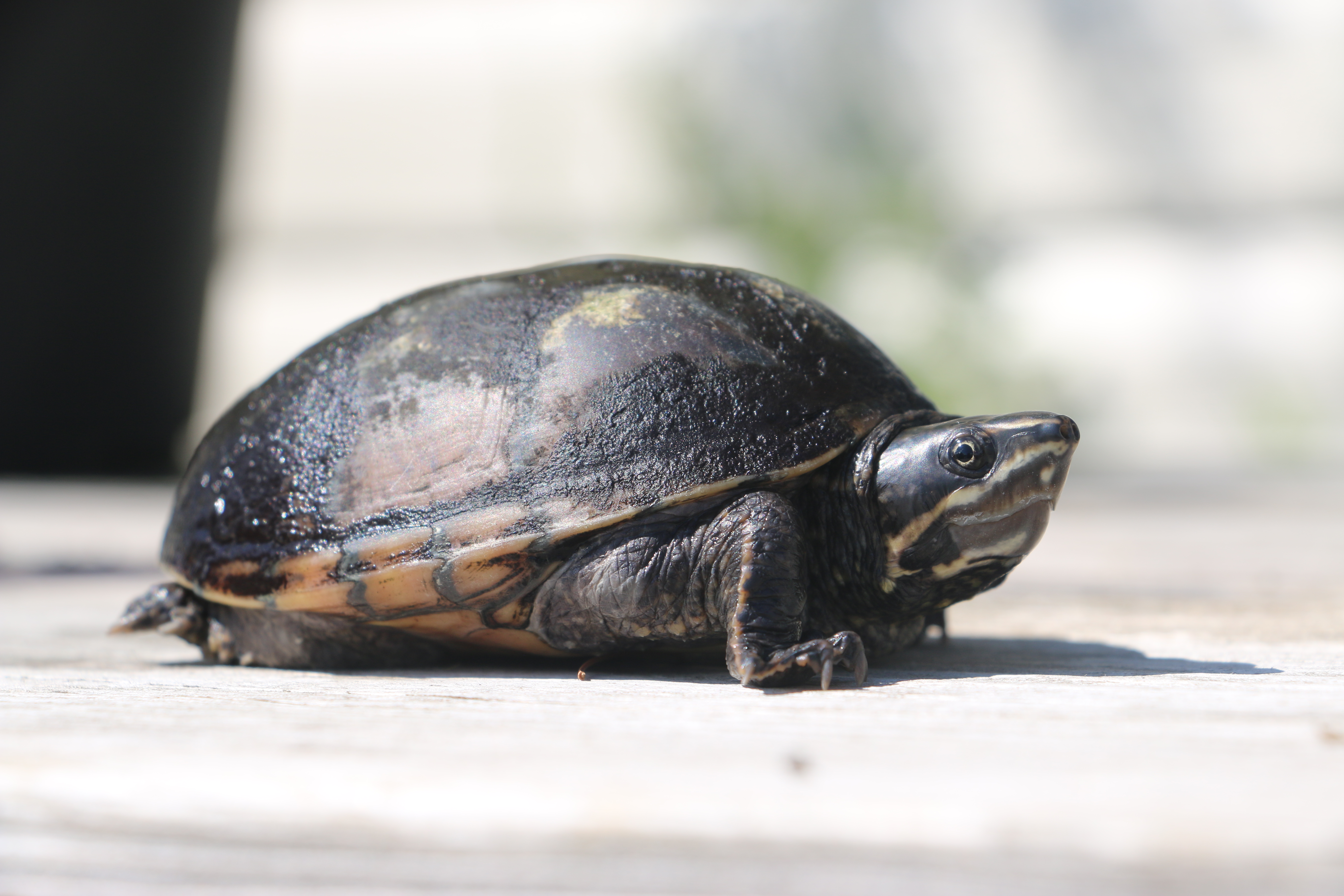
Photo By: Jory Mullen
Conservation Status:
Listed as Special Concern in Canada since 2012 and in Ontario since 2014
Identification:
• Small turtle; carapace length rarely exceeds 13 cm
• Narrow, domed, brown to black carapace with dark spots or streaks
• Carapace is often covered in algae
• Plastron is yellow-brown with some scutes separated by skin
• Plastron hinge is located near the front
• Pointed snout with two light stripes extending from the nose across each side of the head
• Two or more barbels on the chin and throat
Info:
Reptiles are ectothermic; they rely on rock for basking and most are highly aquatic. The Land Between is a refuge for Ontario's reptiles- harbouring approximately 30% of Ontario's turtle population and 25% of Ontario's snake population- both provide essential services such as irreplaceable pest control, biomass, nutrient cycling, and seed dispersal. In Canada, the Eastern Musk Turtle’s range extends from southern Ontario, north to Sudbury and North Bay, and to the southernmost parts of Quebec. The Eastern Musk Turtle is a highly aquatic species that rarely leaves the water except to nest or to access adjacent wetlands. They are most active at dusk and dawn, avoiding the midday sun by basking just below the water’s surface under the cover of floating vegetation. Eastern Musk Turtles are most commonly found near the shores of well-vegetated, shallow waterways with slow currents such as; rivers, bays of lakes, marshes and ponds. They overwinter in shallow waters, burying themselves in the bottom substrate and will occasionally use the burrows of other animals, or muskrat and beaver lodges. During the nesting season, females dig shallow nests in decaying plant matter, rotting wood, or sand and lay 2 to 5 eggs. When disturbed Eastern Musk Turtles will attempt to scratch and bite, and may release a foul, musky-smelling fluid from glands located on the underside edges of the carapace. This predator deterrence is how the Musk Turtle got its name. The Land Between has over 65% of the musk turtles in Ontario.
Special Significance
These species are associated with The Land Between bioregion. It is a reserve for these widlife.
Eastern Hog-nosed Snake (Heterodon Platyrhinos)
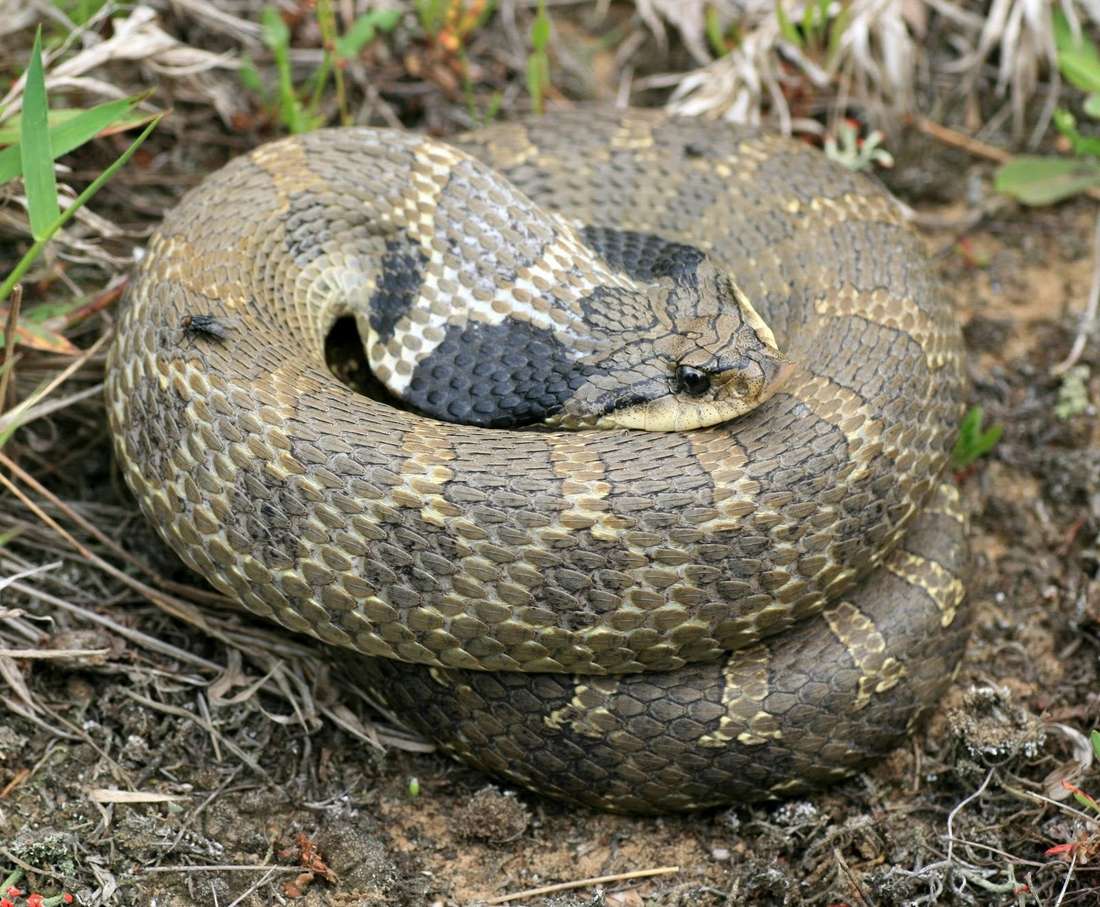
Photo Credit: Scott D. Gillingwater
Conservation Status:
Threatened in Canada since 2003, Threatened in Ontario since 2008
Identification:
• Thick-bodied snake, ~ 115 cm long (upper range)
• Distinctive upturned snout
• Dorsal colouration is highly variable ranging from light to dark with alternating dark blotches, to a patternless dorsal colour of olive or dark grey
• Underside is considerably lighter
• Large, dark blotch behind each eye
• Flattens neck when threatened
Info:
Reptiles are ectothermic; they rely on rock for basking and most are highly aquatic. The Land Between is a refuge for Ontario's reptiles- harbouring approximately 30% of Ontario's turtle population and 25% of Ontario's snake population- both provide essential services such as irreplaceable pest control, biomass, nutrient cycling, and seed dispersal. Within Canada, the Eastern Hog-nosed Snake occurs only in south-central Ontario and can be found in sandy soil environments like beaches, wooded areas, and meadows. They are active predators and highly mobile with a large home range. There is little known about how Eastern Hog-nosed Snakes hibernate, but they have been observed digging individual hibernacula when pre-existing burrows are not available. They lay their eggs in sandy soil beginning in June, and eggs hatch about two months later. The Eastern Hog-nosed Snake is harmless but puts on an elaborate display when threatened, often alarming humans. Along with a cobra-like display of flattening their neck, this snake will also play dead by rolling onto its back, emptying its bowels and releasing blood out of its mouth and cloaca. The Land Between has over 65% of the Eastern hognosed snakes in Ontario.
Special Significance
These species are associated with The Land Between bioregion. It is a reserve for these widlife.
Common Nighthawk (Chordeiles Minor)
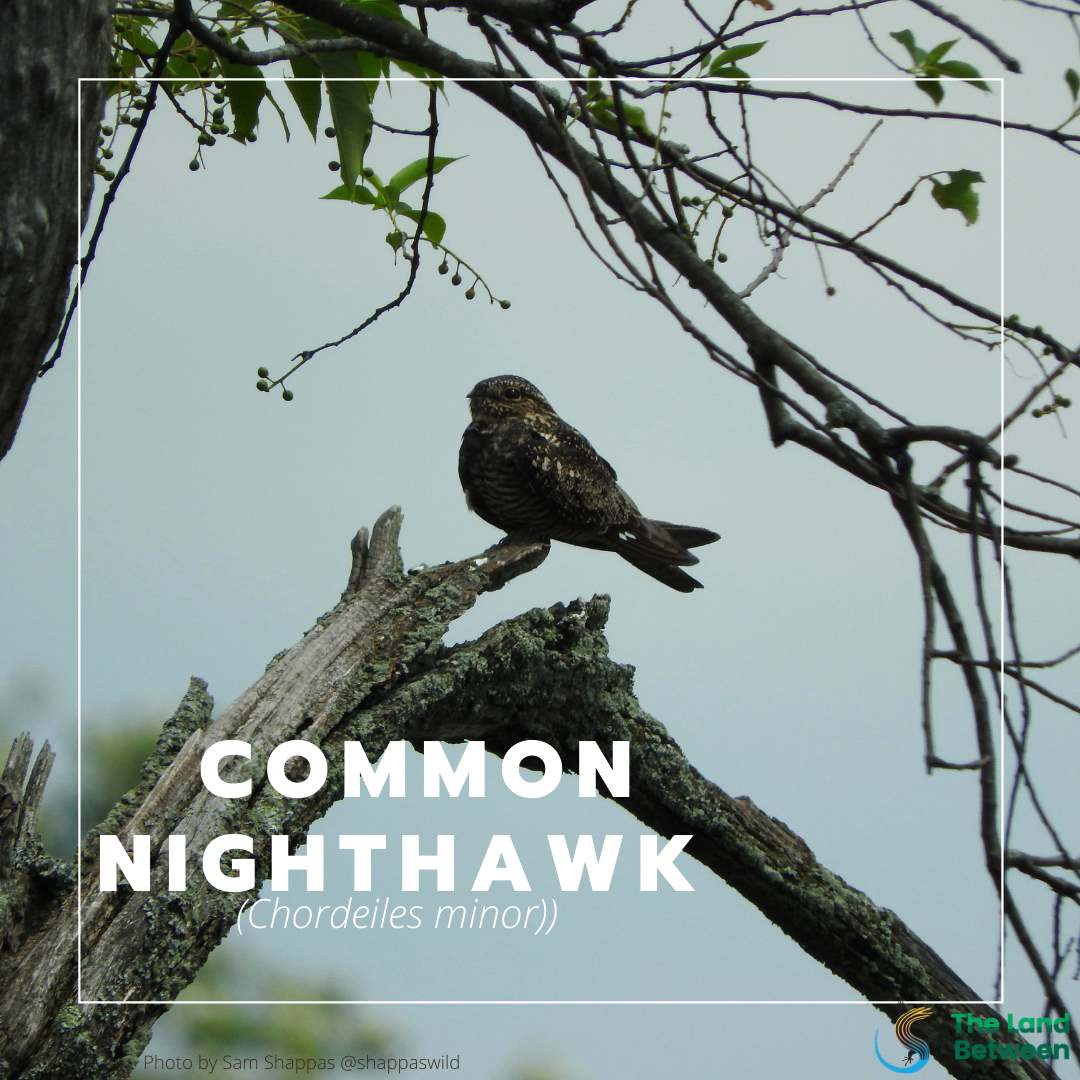
Conservation Status:
Threatened in Canada since 2007, and Special Concern in Ontario since 2009.
Identification:
• Medium-sized bird (70-98 g) with mottled grey and brown plumage, and large, dark eyes
• Long triangular wings, with a bold white bar near the tip
• Males have a white throat patch
• During breeding season the male nighthawk makes a large boom noise which is caused by air passing through his wings
• Distinguishable from Eastern Whip-poor-will by white wing bars, dark horizontal barring on underparts, and its “peent” call
Info:
The Land Between harbours around 70% of this species during breeding season. Common Nighthawks are aerial insectivores consuming thousands of mosquitoes each night. They are important indicator species. Aerial insectivores have declined by more than 90% because of loss of food sources including natural and synthetic insect sprays. Common Nighthawks are a migratory species that breed throughout most of mainland North America, and overwinter in South America. They breed throughout Ontario, but most sightings have been along the southern edge of the Canadian Shield, in the Niagara region, and near Thunder Bay. Common Nighthawks are ground nesters that breed in a variety of open landscapes devoid of vegetation such as forest clearings, sand dunes, rocky outcrops, and gravel rooftops. Early into European settlement in North America, Common Nighthawk populations likely increased with the newly deforested land and introduction of gravel rooftops, however, with continued settlement, the amount of available habitat is declining.
Special Significance
These species are associated with The Land Between bioregion. It is a reserve for these widlife.
Tricolored Bat (Perimyotis Subflavus)

"healthy Tri-colored bat" by USFWS Headquarters is licensed under CC BY 2.0
Conservation Status:
Endangered
Identification:
• Uniform coloration with tricoloured fur on back in three distinct bands
• These small bats weigh only 4.6 - 7.9 g
Info:
The tricolored bat is currently endangered largely due to an invasive fungus that causes white-nose syndrome. Cases of white-nose syndrome has been increasing since 2006 causing an extreme decline in population.
Special Significance
These species are associated with The Land Between bioregion. It is a reserve for these widlife.
Northern Long Eared Bat (Myotis Septentrionalis)

"Northern long-eared bat" by USFWS Headquarters is licensed under CC BY 2.0
Conservation Status:
Near Threatened
Identification:
• Small body size, 8.6 cm on average
• This species has a longer tail and wingspan than other bats of similar size
• Fur and wings are light brown
• Has long pointed ears that will extend well past the nose when folded forwards
Info:
The northern long eared bat is currently threatened by white-nose syndrome. Cases of white-nose syndrome have caused a significant decline in the north-eastern population.
Special Significance
These species are associated with The Land Between bioregion. It is a reserve for these widlife.
Eastern Whip-poor-will (Antrostomus Vociferus)
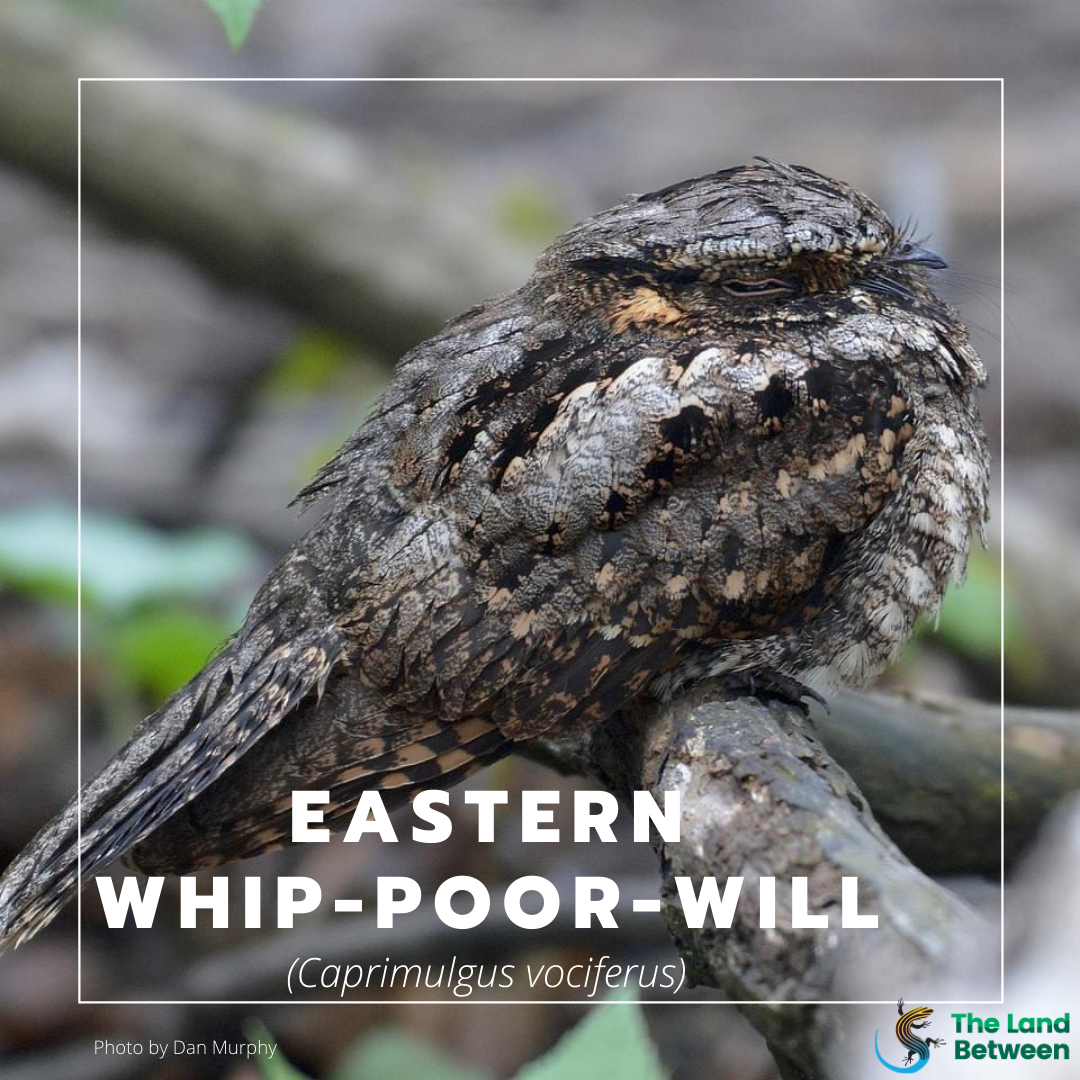
Conservation Status:
Threatened in Canada since 2011 and Threatened in Ontario since 2009.
Identification:
• Medium-sized bird (50-55 g) with mottled grey and brown plumage and large, dark eyes
• Long triangular wings with cinnamon barring
• Males have a rusty patch on cheeks, with a whitish throat stripe and white corners to tail
• Females lack rusty patch, and have a buffy throat stripe and tail corners
• More commonly heard than seen - calls its name (“Whip-poor-will”) at night, especially during a full moon
• Distinguishable from Common Nighthawk by the lack of the white wing bars, cinnamon barring on wings, throat stripe, and sound of call
Info:
The Eastern Whip-poor-will is a migratory species that breeds in most of northeastern United States, and from central Saskatchewan into the Atlantic provinces. In Ontario, much of their breeding population is concentrated in the Land Between, along the Georgian Bay coastline, and up to the northern edge of Lake Superior. Eastern Whip-poor-wills overwinter in southern parts of Florida, eastern Mexico and parts of the Carribean into Panama. They require forested areas next to open landscape to swoop down and forage for insects. Preferred habitats have sparse, irregular trees with good perches such as; forest edges, pine plantations, and regenerated forests after a fire. The Land Between is home to over half of the breeding population of these aerial insectivores. They consume large moths and flying insects. Reduction in food sources due to insecticides and climate change is resulting in declines of this treasured friend.
Special Significance
These species are associated with The Land Between bioregion. It is a reserve for these widlife.
Golden-winged Warbler (Vermivora Chrysoptera)
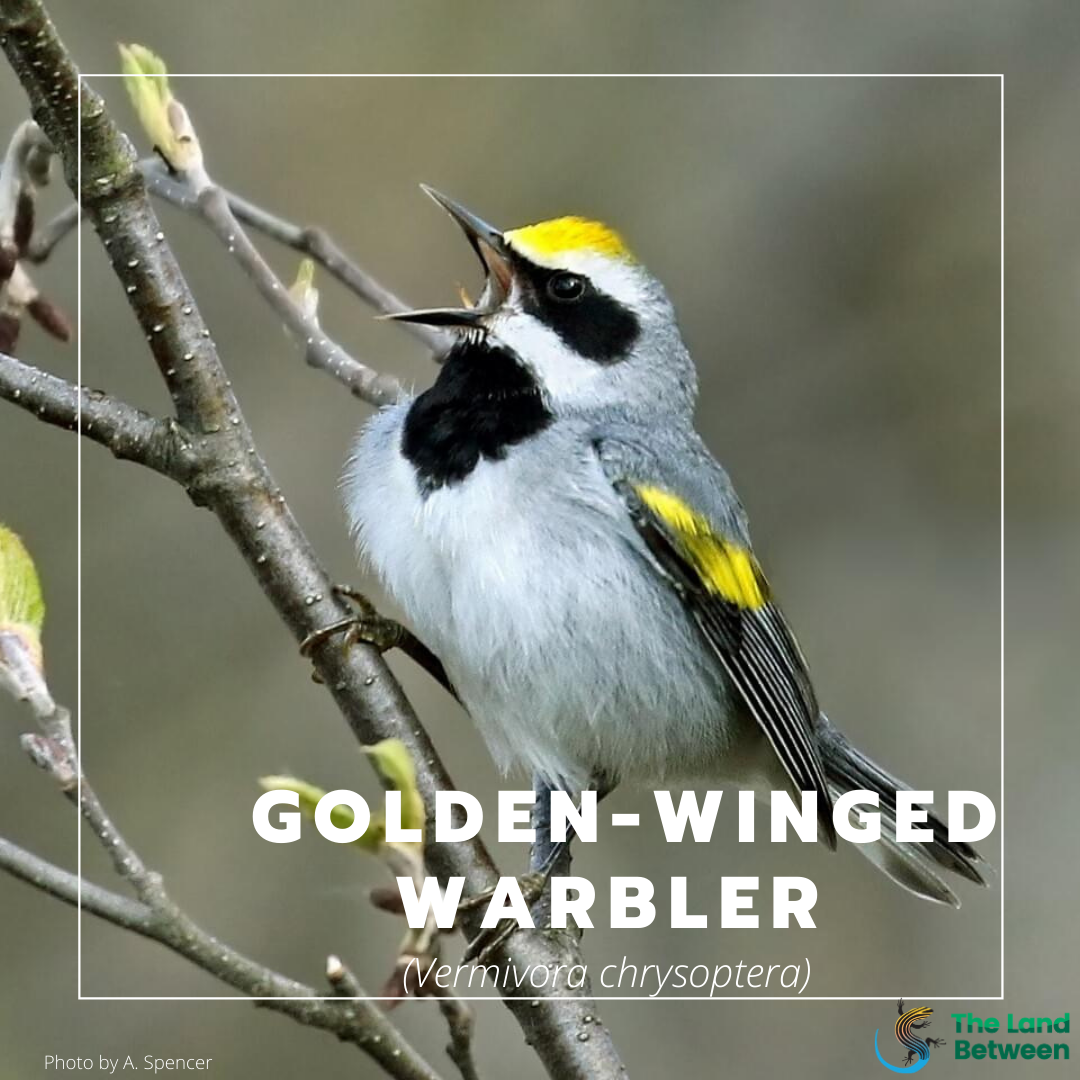
Conservation Status:
Threatened in Canada since 2007, Special Concern in Ontario since 2008.
Identification:
• Small, grey songbird (~ 10 g) with white underside and face
• Males have a black eye-mask and throat, and yellow wing patches and crown
• Females have similar markings but mask and throat are grey
Info:
The Golden-winged Warbler is a migratory species that breeds in much of the north-eastern United States, southern Ontario, and the edges of Saskatchewan, Manitoba and Quebec. They overwinter in Central America. Roughly 79% of the Canadian population breeds within the Land Between. Golden-winged Warblers require habitats of new vigorous growth within close proximity to large mature forests, and an understory of weeds and shrubs. This is typically found where cleared lands are regrowing into forests, as well as in wetlands. After fledging, these birds move into mature forests with dense cover to protect themselves from predators such as hawks.
In the Land Between, shoreline development is altering the treed wetland habitat in which the Golden-winged Warbler is most often found. This local threat could have substantial consequences for the Ontario population.
The Golden-winged Warbler often competes and mates with the Blue-winged Warbler, producing viable offspring. The hybridization of these two is called the Brewster’s Warbler (when the hybrid appears grey like the Golden-winged Warbler) or the Lawrence’s Warbler (when hybrid appears yellow like the Blue-Winged Warbler). Due to land clearing for agriculture, the Blue-winged Warbler has moved further north into the Golden-winged Warbler’s range, increasing the likelihood of hybridization. Over generations the Blue-winged Warbler is replacing the Golden-winged Warbler.
Northern Limit
The Land Between acts as the northern limit for this predominantly southern species.
Woodchuck (Marmota Monax)
Conservation Status:
Species of Least Concern
Identification:
• Stocky with a flattened head
• Short bushy tail
• Fur ranges from yellowish to dark reddish brown
• Forefeet have four claws, hind feet have five
Info:
Often found in open areas such as fields, clearings, open forests, and rocky slopes. They rely on grasses and other short growing plants for food. They spend a majority of their time sunning on warm ground, flat rocks, and low branches. Many other animals rely on woodchuck holes for shelter.
Northern Limit
The Land Between acts as the northern limit for this predominantly southern species.
American Crow (Corvus Brachyrhynchos)
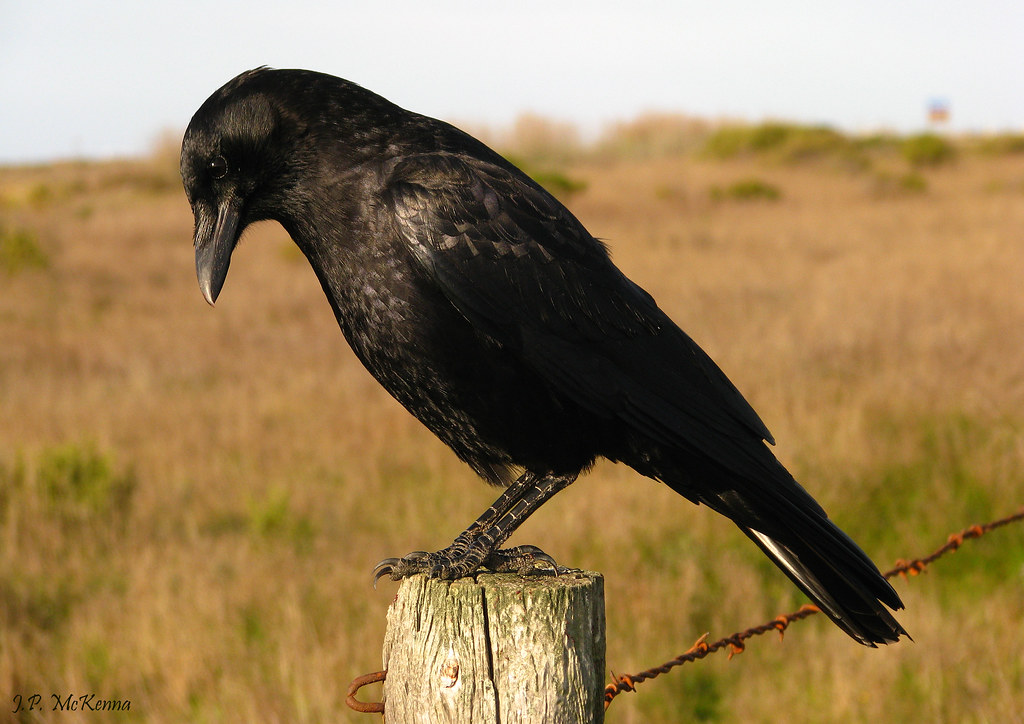
"American Crow - Corvus brachyrhynchos" by jpmckenna - Plotting 2020 Adventures is licensed under CC BY-NC 2.0
Conservation Status:
Species of Least Concern
Identification:
• All black with iridescent feathers
• Can be distinguished from ravens by its smaller size
Info:
Crows can be found in a variety of habitats across North America. Crows live in the south year-round and many migrate north through the land between to breed. Outside of nesting season they often gather in large communal roosts. Currently shown on the map is observation counts ranging from 1 to 101 seperate observations, with darker squares representing a larger number of observations.
Northern Limit
The Land Between acts as the northern limit for this predominantly southern species.
Green Heron (Butorides Virescens)
Conservation Status:
Species of Least Concern
Identification:
• Geenish-black cap
• Greenish back
• wings that are grey-black grading into green or blue
• Chestnut neck with white line down the front
Info:
The Green Heron breeds in inland marshes and alterations of wetlands have been identified as an important threat to this species. Many green herons migrate to the land between to breed before returning south for the winter. They often hunt along shorelines or in shallow water, often dropping food or small objects into the water to attract fish. Currently shown on the map is observation counts ranging from 1 to 67 seperate observations, with darker squares representing a larger number of observations.
Northern Limit
The Land Between acts as the northern limit for this predominantly southern species.
Big Brown Bat (Eptesicus Fuscus)

"Big Brown Bat (Eptesicus fuscus)" by Larry Meade is licensed under CC BY-NC-SA 2.0
Conservation Status:
Least Concern
Identification:
• Body length is 11-13 cm
• Fur is reddish brown, with black ears, and hairless black snout and wing membranes
• The ears are relatively short with rounded tips
Info:
These bats are often attracted to properties because they consume many agricultural pests such as cucumber beetles.
Northern Limit
The Land Between acts as the northern limit for this predominantly southern species.
Northern Cardinal (Cardinalis Cardinalis)

"Northern Cardinal (Cardinalis cardinalis)" by Dominic Sherony is licensed under CC BY-SA 2.0
Conservation Status:
Species of Least Concern
Identification:
• Medium sized songbird, males are slightly larger than females
• Males are bright red with a black mask around their bill
• They have a prominent crest on top of their head
• Females are olive brown with red on their wings, tail, and crest.
Info:
The northern cardinal lives in thickets and bushy areas at the edges of woodlands. Their range has been increasing and now spans from Manitoba to Newfoundland and Labrador. Their diets consist of insects, seeds, and berries. Currently shown on the map is observation counts ranging from 1 to 609 seperate observations, with darker squares representing a larger number of observations.
Northern Limit
The Land Between acts as the northern limit for this predominantly southern species.
Chorus Frog (Pseudacris Triseriata)
Conservation Status:
Threatened in Canada since 2010/ Not Listed in Ontario
Identification:
• Small tree frog, ~ 2.5 cm long from vent to snout
• Olive-grey to brown with three dark dorsal stripes sometimes broken into blotches
• Dark line from snout to groin and white line on upper lip
• Call sounds like running a finger across the teeth of a comb
• Distinguishable from Boreal Chorus Frog by call and separate range
Info:
In Canada, the Chorus Frog occurs only in southern Ontario and southwestern Quebec (the Boreal Chorus Frog occurs in northern Ontario and the central provinces). Chorus Frogs are poor swimmers and only spend about 20 days of the breeding season in aquatic habitats. They are one of the first frogs to call in the spring, sometimes as early as March, and can start breeding before the water is free of ice. Chorus Frogs lay their eggs in shallow, often temporary water bodies such as flooded fields, ditches, and swamps to avoid aquatic predators. Terrestrial habitat is often selected based on proximity to breeding ponds, but grassy or wooded areas near water, or damp, open habitats are preferred. Chorus Frogs are freeze-tolerant and hibernate under rocks, logs, leaf litter, and loose soil. Currently shown on the map is observation counts ranging from 1 to 35 seperate observations, with darker squares representing a larger number of observations. Wetland conversion, insecticides, excess nutrients and habitat fragmentation all play a role in species declines. Amphibians are the fastest declining species in the world.
Southern Limit
The Land Between acts as the southern limit for this northern species.
Mink Frog (Lithobates Septentrionalis)
Conservation Status:
Species of Least Concern
Identification:
• Olive to brown with dark spots or mottling on the sides and hind legs
• The belly is yellowish
• Large tympani
• Extensive webbing on hind feet, reaches the last joint of the longest toe
Info:
Named for their musky scent which is similar to a mink. Rarely found on land, they inhabit large permanent ponds, lakes, slow moving rivers, and sphagnum bogs. A large chorus of mink frogs sounds like popcorn popping. Currently shown on the map is observation counts ranging from 1 to 31 seperate observations, with darker squares representing a larger number of observations. Wetland conversion, insecticides, excess nutrients and habitat fragmentation all play a role in species declines. Amphibians are the fastest declining species in the world.
Southern Limit
The Land Between acts as the southern limit for this northern species.
River Otters (Lontra Canadensis)

Conservation Status:
Species of Least Concern
Identification:
• Brown water-repellent fur
• webbed feet
• long tails
• Their underbody is usually lighter in colour
Info:
River otters can be found in every province and territory except Prince Edward Island. They live near rivers, lakes and creeks. Their burrows are often built to be accessible from both on land and in the water. Currently shown on the map is observation counts ranging from 1 to 13 seperate observations, with darker squares representing a larger number of observations.
Southern Limit
The Land Between acts as the southern limit for this northern species.
Common Loon (Gavia Immer)
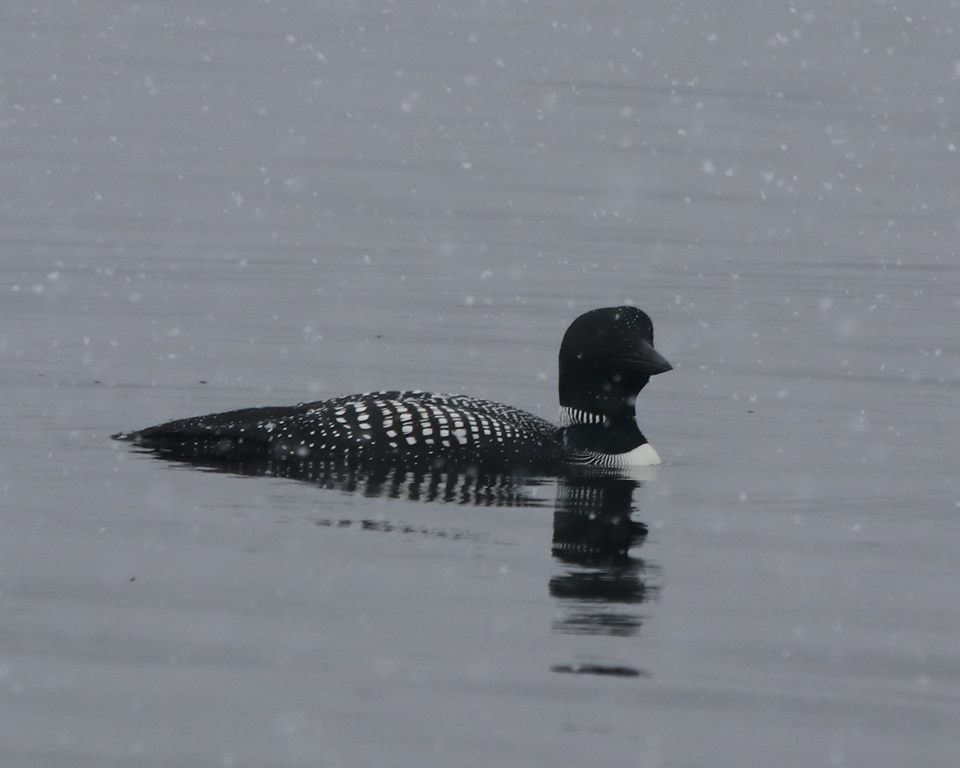
Conservation Status:
Species of Least Concern
Identification:
• broad black head and neck with a greenish, purplish, or bluish sheen
• Black or blackish-grey upper parts with white underparts
• Red eyes
• has a checkered black and white mantle
Info:
Loons nest on shorelines, constructing mounds of marsh grasses. The loon is the provincial bird of Ontario. They favour lakes with islands and coves.
Southern Limit
The Land Between acts as the southern limit for this northern species.
Common Raven (Corvus Corax)

Conservation Status:
Species of Least Concern
Identification:
• One of the two largest Corvids alongside the thick-billed raven
• long, graduated, wedge shaped tail
• black iridescent plumage
• dark brown iris
• neck feathers are pale brownish-grey
Info:
Able to thrive in a variety of habitats, the raven has one of the largest ranges of any passerine. They prefer wooded areas with nearby open land, or coastal regions. Currently shown on the map is observation counts ranging from 1 to 54 seperate observations, with darker squares representing a larger number of observations.
Southern Limit
The Land Between acts as the southern limit for this northern species.
Black-backed Woodpecker (Picoides Arcticus)
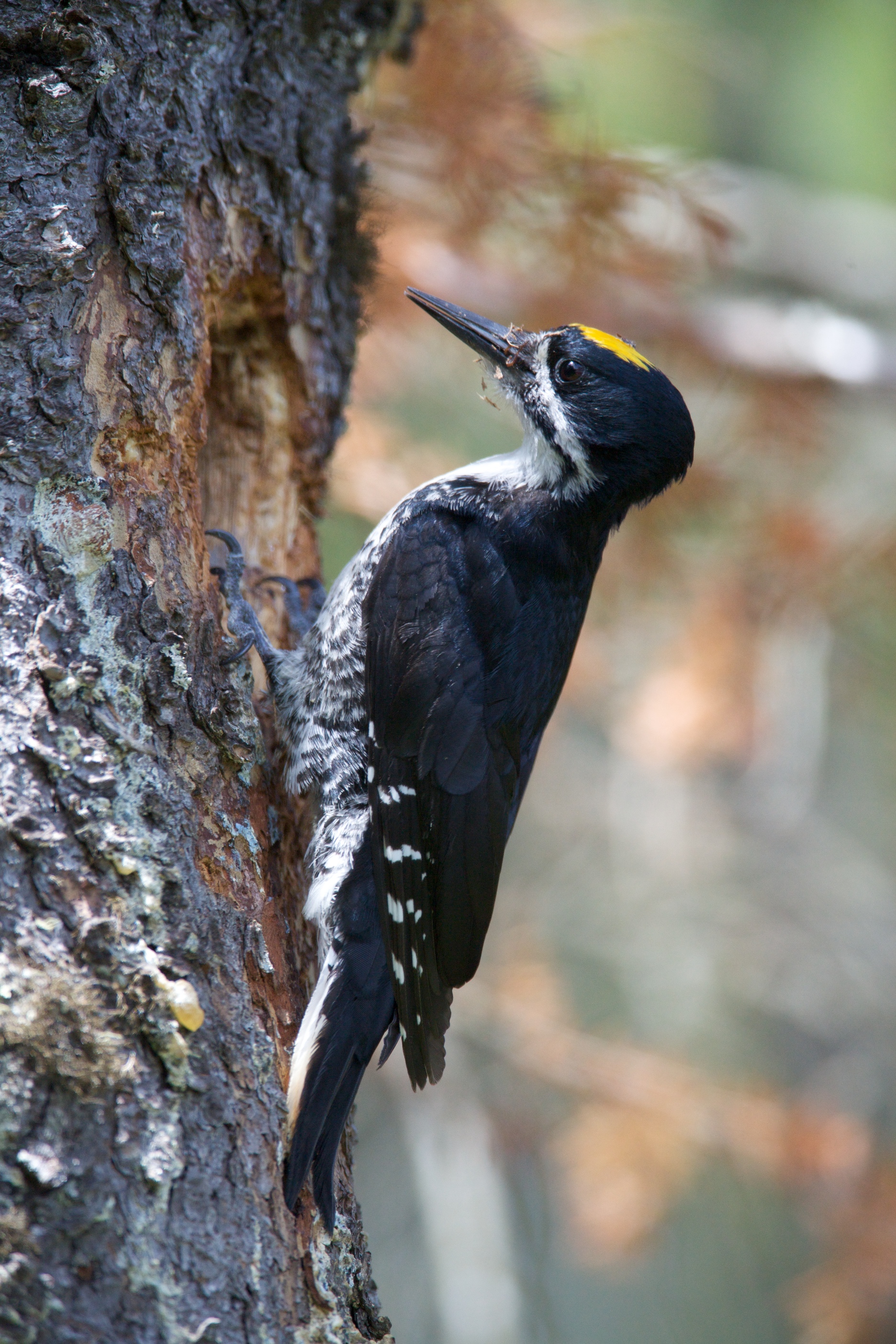
"Black Backed Woodpecker" by U. S. Fish and Wildlife Service - Northeast Region is licensed under CC PDM 1.0
Conservation Status:
Species of Least Concern
Identification:
• Mostly black with a white stripe on the face.
• Males have a yellow crown patch.
• White throat and belly
• Females have white bars on their flanks
Southern Limit
The Land Between acts as the southern limit for this northern species.
Gray Jay (Perisoreus Canadensis)
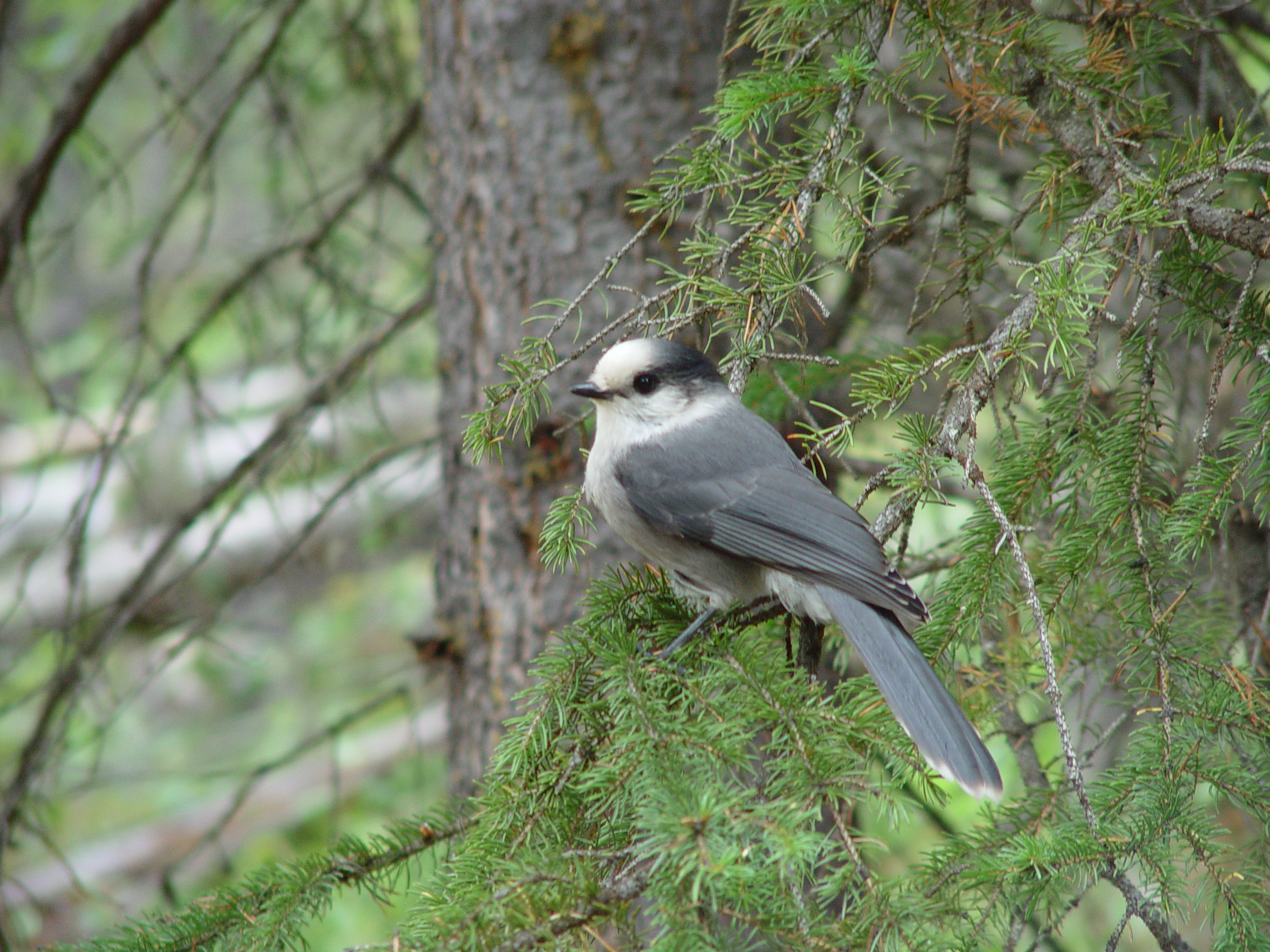
"Gray Jay (Perisoreus canadensis)" by Franco Folini is licensed under CC BY-SA 2.0
Conservation Status:
Species of Least Concern
Identification:
• Adults are dark gray with a lighter belly, and white face and throat.
• Juveniles are a darker gray with a white stripe on their face.
• While smaller than other jays, they are considered large songbirds.
Wolves and Coyotes
Due to human residential development coyotes, a species that thrives in open habitats and is native to the southwestern parts of the USA, have been able to establish a foothold in Ontario and in The Land Between bioregion. They consume large amounts of prey biomass. Meanwhile, wolf habitat has been lost to over-development. Today, young wolves leaving packs will not readily encounter other wolves to breed, but instead are likely to hybridize with coyotes. The threats and limitations that wolves are facing mean that wolves are now listed as a species at risk of becoming extinct.
The Land Between is an interesting meeting place for these two species; and an area where more research is possible and needed to understand these interactions, also the impacts of development, of the coyote and of the hybrid species, on native wildlife and the natural ecosystem.
This map shows current (2019) observational locations of wolf and coyote observations with red representing areas where only coyotes have been observed, green representing wolves, and yellow where both species are present.
Wolf (Canis Lupus) - Southern Limit Species

"Wolf" by Dennis from Atlanta is licensed under CC BY-SA 2.0
Conservation Status:
Species of Least Concern
Identification:
• Can be distinguished from other canis species by its less pointed ears and muzzle, as well as shorter torso and long tail
• Has longer legs than most other canids
• Very dense fur consisting of a short undercoat and long, coarse guard hairs which determine its colour
Info:
Wolves live in a variety of habitats but their range has been significantly reduced by humans. They work in packs to hunt large herbivorous mammals such as deer and moose. Canada is an important stronghold for the species and wolves are a protected species in national parks.
Coyote (Canis Latrans) - Northern Limit Species

Conservation Status:
Species of Least Concern
Identification:
• colour can vary but is predominantly light grey and red, interspered with black and white
• Typically smaller than wolves, with longer ears
• Muzzle forms an almost continuous line with the forehead
• Yellow slanting eyes with black round pupils
• Paws are more elongated than most dogs
Info:
The coyote is an introduced species that has moved to the region following development. It prefers open habitats and is not afraid of humans. Hybridization with the wolf has a devastating impact on wolf populations. Additionally, coyotes and the hybrid species have unquantified but concerning impacts on mesopredators such as weasels, beavers and other mammals. Coyotes prefer open or semi-wooded habitats. They often bed down in thickets. They often travel long distances, up to 16km per day and are competent swimmers. Although often persecuted by humans, their range has greatly expanded as populations of wolves and cougars dropped. People have also created many conditions that benefit them such as the clearing of forests, provision of carrion, and introducing domestic livestock.
This Leaflet Storymap was created for The Land Between by Michael Rose.